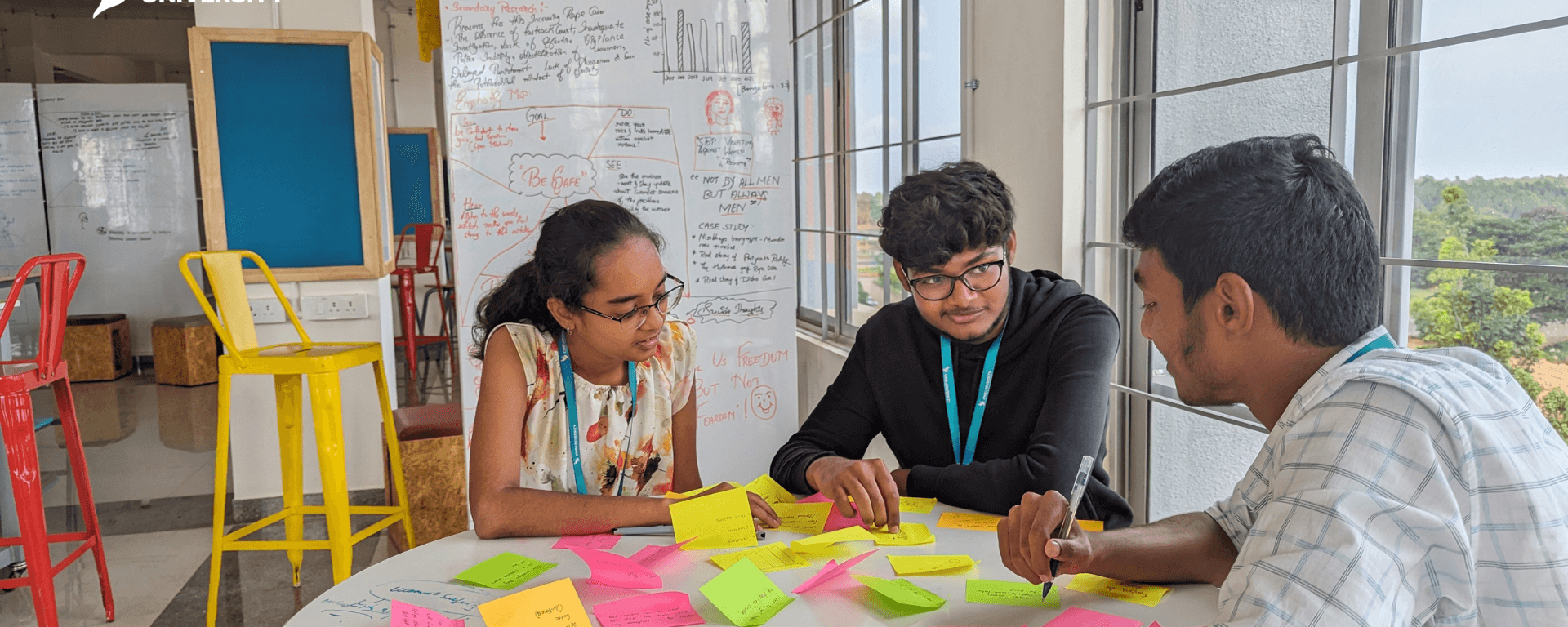What happens when young minds are given the tools to think empathetically, solve creatively, and act responsibly? At CMR University, we’re seeing the answer unfold in real time, in real villages, and in real lives.
Design Thinking here isn’t just a course module or academic buzzword. It is a mindset. One that’s embedded into how our students approach the world’s most urgent and complex challenges, especially those rooted in rural India.
Where empathy meets innovation
At the heart of our social innovation model is immersion, the idea that you can’t fix what you don’t fully understand.
That’s why we launched the Rural Immersion Camp in Kolar. It is one of our flagship experiences, where students leave behind the comfort of their classrooms and spend time living and learning in Karnataka’s villages. They interact with local communities, observe their routines, identify pain points, and begin to see problems not as case studies, but as lived experiences.
“Design Thinking begins with empathy,” I often remind my students. “All problems are human problems. To truly solve them, we must first understand them at a granular, personal level.”
What follows is powerful: a series of student-led projects that are making sustainable, real-world impact across rural Karnataka.
Student Innovations Driving Social Change
Every project you’ll read about below follows the five phases of Design Thinking: Empathise, Define, Ideate, Prototype, and Test. Many of them are aligned with the UN Sustainable Development Goals (SDGs) and all are shaped by our ethos: Knowing Self and Community, Preparing for Success and Contributing to Society
1. ULUME: Empowering Karnataka’s Small Farmers Through Tech
ULUME is a student-built digital platform designed to tackle the day-to-day struggles of small and marginal farmers: lack of market access, rising input costs, and limited advisory services.
What ULUME offers:
- A direct-to-consumer marketplace so farmers can sell produce without middlemen
- Personalised farming advice in Kannada and other local languages, delivered via a mobile app
- Training in climate-resilient and organic farming techniques
Over 50 farmers have already joined the platform, with pilot projects running for guava, ragi, and corn. It’s not just a tech solution — it’s a step towards agricultural self-reliance.
2. Smart Soil Moisture Irrigation System: Precision Farming for Water-Stressed Regions
Water is precious and increasingly scarce, especially in Karnataka’s drought-prone belts. In response, our students engineered a Smart Soil Moisture Irrigation System using IoT technology.
Key highlights:
- Real-time soil moisture tracking through affordable sensors
- Automated control of irrigation pumps to minimise water waste
- Remote monitoring via the Blynk IoT platform
This solution has the potential to improve yields, reduce water consumption, and cut labour costs; all while being affordable and scalable for small farmers.
3. Bio Nanocellulose Packaging: From Rice Straw to Eco-Friendly Products
Here’s a beautiful example of circular thinking. Every year, tonnes of rice straw are burnt after harvest, a practice that worsens air pollution. Simultaneously, plastic-coated disposable cups continue to clog our landfills.
The student solution? Convert rice straw into biodegradable nanocellulose film, an eco-friendly alternative to plastic.
This film can be used to make:
- Disposable cups and plates
- Straws
- Food packaging and wrapping material
It’s sustainable, scalable, and offers an additional revenue stream for farmers. Most importantly, it reframes agricultural waste as a valuable resource.
The Bigger Picture: Preparing Students for Life, Not Just Work
At CMR University, our curriculum prioritises purpose alongside professionalism. We want students to build careers, yes. But we also want them to build conscience. To see the world not just as a marketplace, but as a community.
The goal isn’t fast fixes. It’s deep, human-centred problem solving. And that begins with asking better questions, listening with empathy, and designing with intention.
As I often tell my students, “The world doesn’t just need smart people. It needs people who care.”
These projects are more than assignments. They’re proof that education, when done right, can be an engine for grassroots change.Through design thinking, rural immersion, and hands-on learning, our students are becoming problem solvers, not just job-ready, but life-ready.
And that, to me, is the true impact of research and innovation at CMR University.
